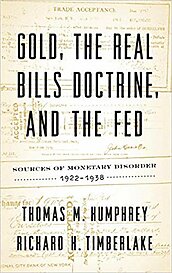The gold standard is often blamed for causing “the Great Contraction” — the unprecedented collapse of the U.S. money stock that began after the 1929 stock market crash and led to the Great Depression.
In Gold, the Real Bills Doctrine, and the Fed: Sources of Monetary Disorder, 1922–1938, preeminent monetary historians Thomas M. Humphrey and Richard H. Timberlake thoroughly refute that claim. Instead, they identify the culprit as a now relatively unknown, but once highly influential, theory: the Real Bills Doctrine. The Fed’s failure to stem the Great Contraction was due, not to any shortage of gold, but to Fed official’s devotion to a doctrine that made them unwilling to make full use of the United States’ ample gold reserves.
Anyone interested in understanding the causes of Great Depression, and particularly the part prevailing economic theories played in it, should regard Gold, the Real Bills Doctrine, and the Fed: Sources of Monetary Disorder, 1922–1938 as an absolutely essential work.
